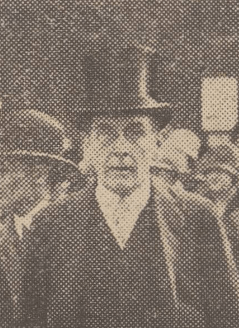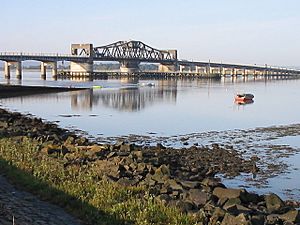Alexander Gibb facts for kids
Quick facts for kids
Brigadier-General
Sir Alexander Gibb
|
|
|---|---|

Gibb at the wedding of his eldest son, Alistair, in 1927
|
|
| Director-General of Civil Engineering, Ministry of Transport | |
| In office 1919–1922 |
|
| Civil Engineer-in-Chief to the Admiralty | |
| In office 1918–1919 |
|
| Personal details | |
| Born | 12 February 1872 Broughty Ferry, Forfarshire, Scotland |
| Died | 21 January 1958 (aged 85) Hartley Wintney, Hampshire, England |
| Nationality | British |
| Spouses | Norah Isobel Monteith, m. 1900-1940 (her death) |
| Children | 3 |
| Engineering career | |
| Discipline | Civil |
| Institutions |
|
| Practice name | Sir Alexander Gibb & Partners |
Brigadier-General Sir Alexander Gibb (born February 12, 1872 – died January 21, 1958) was a famous Scottish civil engineer. A civil engineer designs and builds big projects like bridges, roads, and buildings. Sir Alexander Gibb worked for the Admiralty (the navy's department) and the Ministry of Transport. Later, he started his own engineering company called Sir Alexander Gibb & Partners.
Contents
Early Life and Military Service
Alexander Gibb was born in Broughty Ferry, Forfarshire, Scotland. His father, Alexander Easton Gibb, was also a civil engineer. Alexander followed in his family's footsteps. His great-grandfather, John Gibb, was an early member of the Institution of Civil Engineers. This is a group for professional engineers. John Gibb even worked with Thomas Telford, a very famous engineer.
Alexander went to school at the High School of Dundee and Rugby School. He also studied at University College London. After a year, he left to train with well-known civil engineers John Wolfe Barry and Henry Marc Brunel. This was like an apprenticeship.
In 1900, Gibb joined his father's company, Easton, Gibb & Son. They were building the King Edward VII Bridge at Kew at the time. That same year, he married Norah Isobel Monteith. They had three sons together.
Wartime Contributions
During the First World War, Gibb worked on the Rosyth naval dockyard. He helped speed up its construction so it could be used sooner. In 1916, he became the Chief Engineer for Ports Construction for the British Armies in France and Belgium.
He was in charge of repairing Belgian harbors and making sure Belgium had enough water. He also helped create special landing places for ferries crossing the English Channel. These were at Dieppe, Calais, and Dunkirk.
For his important work during the war, Gibb received special awards. He was made a Companion of the Order of the Bath and a Knight Commander of the Order of the British Empire. Later, he became the Civil Engineer-in-Chief for the British Admiralty. This meant he was responsible for all naval engineering projects. One of his projects was designing a huge anti-submarine boom across the English Channel. This boom helped protect ships from enemy submarines.
Later Career and Major Projects
In 1919, Sir Alexander Gibb joined the Ministry of Transport. He became the Director-General of Civil Engineering. He worked on many important committees. These included groups that looked at London traffic and railway electrification. He also advised the government on big engineering projects.

In 1922, Gibb started his own company, Sir Alexander Gibb & Partners. His company worked on many different projects around the world. Some of these included:
- The Barking Power Station, which generates electricity.
- The Galloway hydro-electric power scheme, which uses water to create power.
- The Kincardine Bridge in Scotland.
- Studies for the port of Rangoon in Myanmar.
- Work at the Singapore Naval Base.
In the 1930s, his company started working more in the industrial sector. They helped build the Guinness brewery in Park Royal. When the Second World War began in 1939, his firm designed and supervised three ordnance factories. These factories made weapons and supplies for the war effort.
Sir Alexander Gibb also wrote a book called The Story of Telford: The Rise of Civil Engineering. It was about the famous engineer Thomas Telford, who his great-grandfather had worked with.
Gibb slowly became less involved with his company after 1945. He passed away at his home in Hartley Wintney, England, on January 21, 1958.
Honours and Awards
Sir Alexander Gibb received many honours throughout his life. In 1914, he became a Fellow of the Royal Society of Edinburgh. This is a group that recognizes top scientists and thinkers.
He was also elected a Fellow of the Royal Society in 1936. This is one of the oldest and most respected scientific organizations in the world. He was also the president of many professional engineering groups, including the Institution of Civil Engineers. He was the first civil engineer to be appointed to the Royal Fine Arts Commission. This group advises the government on matters of public art and architecture.
Gibb received an honorary degree from the University of Edinburgh. He also received awards from other countries, including the American naval Distinguished Service Medal. He was also recognized by Belgium, Colombia, and Latvia.
Gibb was also a prominent Freemason. He held important positions within the Freemasonry organization in Scotland.

